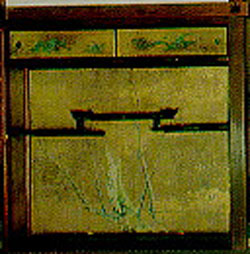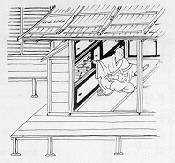

 Furthermore,
evidence shows that these were installed in both Yoshimasa's Kokawa palace
and his Higashiyama residence. To the left is the Picture Scoll of Kasuga
Gongen Miracles from the 14th Century showing the artistic evidence of
the built-shelves.
Furthermore,
evidence shows that these were installed in both Yoshimasa's Kokawa palace
and his Higashiyama residence. To the left is the Picture Scoll of Kasuga
Gongen Miracles from the 14th Century showing the artistic evidence of
the built-shelves.
The main purpose of the chigai-dana of this time was to
provide a place for the artistic arrangement of books and tea utensils.
The function of holding books was a direct influence of Zen monks. During
this time there was extensive trade with China and Korea, which resulted
in an enormous influx of literary and philosophical texts. Only after these
imported texts were tea utensils displayed on these shelves. Typically
this included a tea cup, tea caddy, tea whisk, food canister, tea ladle,
portable fireplace, feather broom, ember poker, and water bowl.
[Main Page] [Development] [Functions] [Features] [Display Elements]